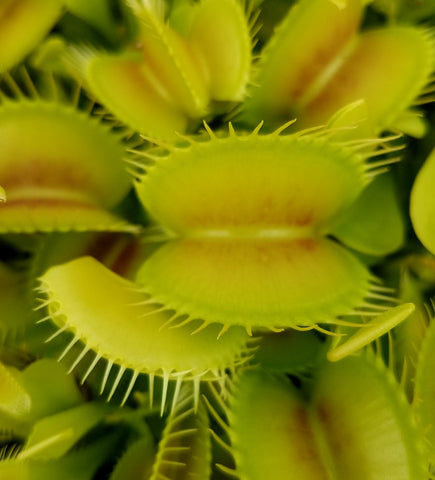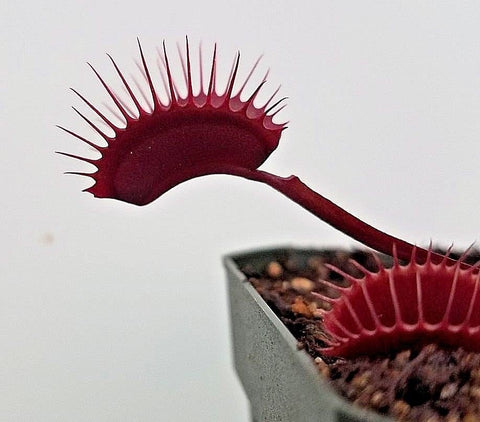This flytrap lives up to it's name! It is the product of crossing three cultivars prized for their size. The foliage is a deep green that extends to the traps. The traps feature a rich, almost wine color interior. There also have long, prominent cilia (teeth). Produces white flowers on stems high above the foliage. Wonderful at capturing nuisance insects such as flies and mosquitoes.
All flytraps will begin entering dormancy starting in the Fall and extending into Spring. During this time, they will produce smaller traps that hug the ground. They will also slow a bit. Once temperatures warm and daylight extends, they will resume producing large, robust traps.
Venus Flytrap care: These plants enjoy part shade and must be grown outdoors for long term success. They are native to an area on the border between North and South Carolina meaning that they can tolerate a larger range of temperatures. Never allow the pot to dry out; the soil must stay moist at all times. The best way to do this is using the ‘tray method’. Simply put, have the pot sit in a tray that is always about ½” deep with water. Do not use tap or well water, these sources are high in ‘total dissolved solids (tds). Instead use rain, reverse-osmosis (RO), distilled, etc. Dormancy is important. Do not allow pot to freeze but a cold spell of temperatures around 40°F for around 3 months is beneficial. If you are in Zone 8 or higher, you can leave the plant outside in a pot with no issues (bring inside if there is a hard freeze). If in Zone 4-7, plant the flytrap in the soil and protect with a thick layer of pine needles. During dormancy the flytrap will produce smaller, more compact traps that hug the soil. These traps will be lethargic and will trigger slowly or not at all. When temperatures warm up during spring, the plants will replace their winter traps with full sized, robust traps. *Never touch the inside of or feed the traps “people food” such as ground meat. These plants are masters at catching insects such as spiders, and flies. It’s important to remember that traps are modified leaves so it is normal for old traps to die and new ones to grow. Individual traps will only trigger a finite number of times before they will no long function and die.









